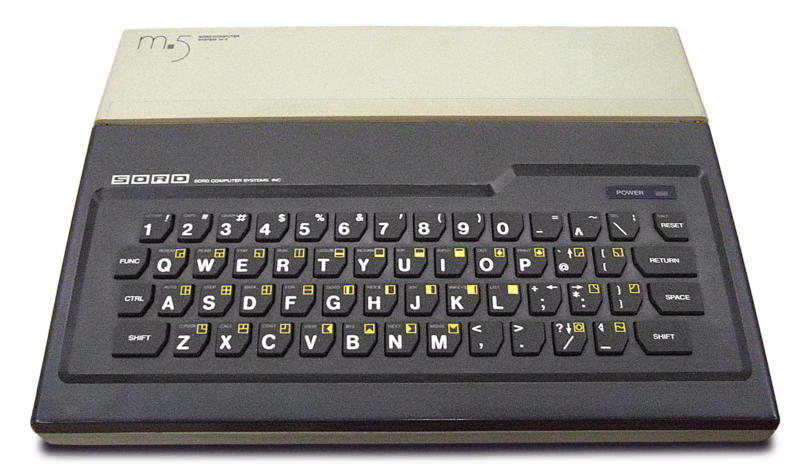Computer facts
| Company | Sord Computer Corporation |
|---|---|
| Type | home |
| Year | 1982 |
| Language | Cartridge based: Basic-G (graphics and sound), Basic-I (integers) and Basic-F (floating point) |
| CPU | Zilog Z80A |
| Speed | 3.58 MHz |
| RAM | 4 KB (36 KB maximum), 16 KB VRAM |
| ROM | 8 KB (28 KB maximum) |
| Text modes | 40 x 24 |
| Graphic modes | 32 x 24, 64 x 48, 256 x 192 |
| Colors | 16 |
| Sound | SN76489AN: 3 voices (6 octaves), 1 noise channel, 7 special sounds |
| IO | RF TV output, video & audio outputs, Joystick (2), Cartridge slot, Tape interface (2000 baud), Centronics (printer) |

In my collection
Sord M5
Boxed with powersupply. Looking for joysticks.Part of a bigger computer trade with Mikael Holm.
Trivia
The SORD M5 had no really great success outside Japan (and later Czechoslovakia) but had lot of interesting characteristics, very close to MSX computers released soon after.
Its design was quite original. The machine xas quite small. The two-tone grey plastic casing opened to reveal a bright yellow back, which housed the ROM cartridge slot. The keyboard was similar to the rubber matting of the Spectrum, but felt markedly better. Most keys had a Basic keyword on them in small light-grey letters (available by holding down the function key as an other key is pressed). There was no full-size space-bar.
There was only 4K of internal RAM, but memory expansions were available. The joysticks simply plugged into tiny DIN sockets, and there was a port for a Centronics printer. The power supply was external and rather cumbersome.
It used a dedicated video chip (Texas Instrument 9918, 9928 or 9929, depending on the model) and had the same video characteristics as the MSX computers (same graphic resolution, same number of colors, same number of sprites, etc.) but didn't belong to this family. The M-5 had 32 graphics symbols in ROM and could handle up to 32 sprites. Its sound chip was the Texas Instruments TI 76489, which wasn't MSX compliant. It had three independent sound channels which could produce a variety of music and synthesised sounds. The sound was sent through the TV speaker.
Several cartidge based languages were available: the Basic-I (very simple version for beginners, delivered with the system), the Basic-G (with lot of graphic commands) and the Basic-F (for mathematic and scientific applications). The M-5 supported Inp and Out in Basic to control Z-80A ports, but had no obvious connector to the external world other than the ROM cartridge slot into which the Basic cartridge had to be be inserted.
One year later the M5 Pro and M5 Jr were released with a built-in power supply unit (and more RAM?).
(Text from www.old-computers.com)
